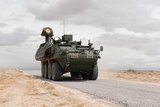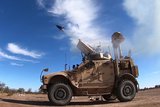Raytheon places weapons upgrades at the heart of air dominance (Studio)
Brought to you in partnership with Raytheon Missiles & Defense
In today’s battlefield, assets in all domains – air, land, sea, space and cyber – need to interact and reinforce one another like never before. For the US and its allies, dominating the air will be crucial, both as a domain in its own right and as a critical element of executing the ground missions, among other priorities.
‘It’s about controlling the skies and dictating the terms of the fight,’ said Alison Howlett, senior programme director for the StormBreaker precision weapon at Raytheon Missiles & Defense.
The manufacturer aims to ensure that ‘we have that combat overmatch going in, whether it’s air-to-air or air-to-ground’.
Steve Dickman, Raytheon’s programme director for the Advanced Medium-Range Air-to-Air Missile (AMRAAM), said the company’s goal is to help its customers retain ‘that unfair advantage… the technologies and weapon systems we bring deliver that ability to operate and engage throughout the battlespace’.
An F-35A Lightning II test aircraft released AMRAAM and AIM-9X Sidewinder missiles at QF-16 targets during a live-fire 2018 test. (Photo: US Air Force)
As the battlespace evolves, so do Raytheon’s weapon systems. AMRAAM has been produced for more than 30 years and is in service for 41 countries worldwide. Despite the missile’s decades of operation, Raytheon continues to upgrade and improve the weapon year over year, Dickman said.
‘From tip to tail, we’ve probably refreshed just about everything within that weapon, making it available to both fourth and fifth-generation fighter aircraft,’ from the F-35 to the Eurofighter.
AMRAAM offers an onboard active radar and an all-weather capability, providing a wide employment envelope for operators. Dickman said this manoeuvrability and flexibility were crucial in the MDO battlespace, for both the US and international partners.
Today, the primary upgrade focus is the Form Fit Function Refresh programme, or F3R. This effort is upgrading the missile in a range of areas, bringing in new high-speed processors, GPS receivers, and a modified inertial navigation system (INS), among other improvements.
To date, there have been two live fires of the upgraded missile from an F-18, with the company working closely with the US Air Force and Navy.
The upgrade work will give AMRAAM enhanced capability against advanced threats, Dickman added, a critical component of air dominance over peer and near-peer rivals.
Importantly, these hardware upgrades will be combined with software advances, Dickman said, pursued through various iterations of the System Improvement Program (SIP).
He explained that the company plans to upgrade the software architecture in the coming years, supporting the missile’s growing capability to operate in adverse environments, such as in a contested electronic warfare (EW) scenario.
‘As we think about air dominance, we need to stay one step ahead of the adversary,’ Dickman said.
StormBreaker is an air-to-ground, precision smart weapon. As the name suggests, it provides users with an all-weather capability from standoff ranges, with the ability to see through obscurants like fog, sand and dust.
The weapon’s flexibility is delivered through a tri-mode seeker, which combines a millimetre-wave radar with imaging infrared and a semi-active laser. With the ability to glide for 45 nautical miles, the missile is designed to support air interdiction, Howlett said.
The weapon is network-enabled, a key advantage in the era of MDO, also known as Joint All-Domain Command and Control (JADC2).
An integrated data link provides this capability, enabling StormBreaker to engage moving targets, a key differentiator in peer rivalries.
‘Once the weapon’s dropped, it can be retargeted or reprioritised for different targets, depending on what’s happening in the battlespace,’ Howlett explained. ‘It allows for overall agility in a network-enabled environment.’
StormBreaker’s tri-mode seeker is perhaps the most exciting element of the weapon, Howlett said, with each mode providing a specific advantage, reinforcing the others.
The laser provides the highest levels of accuracy, particularly in complex urban environments, but it can struggle through fog and sandstorms. The radar can see through those conditions, while it also helps with moving targets. The uncooled infrared camera, meanwhile, helps build a picture of the target.
Howlett said the system was able to take input from these different modes, run it through its algorithms, and then identify, distinguish and prioritise the targets in front of it.
‘StormBreaker is currently fielded on the F-15E. We have done over 150 test shots in preparation to make sure that we understand the capabilities of the weapon. We're focused now on integration for the F/A-18 and the F-35.’
Raytheon Missiles & Defense is looking to the future, asking how its systems must adapt to support air dominance in the decades ahead. Dickman said the company is investing in the next generation of seekers, with his business collaborating closely with Raytheon’s Advanced Technology mission areas on the work.
Such research reflects the priorities of the US Department of Defense and allies: range and speed to target.
‘A lot of that translates into what we’re doing on the AMRAAM programme,’ Dickman said. ‘For example, we’re looking at extended range motors, asking how we [integrate such technology and] stay within the footprint of the existing AMRAAM programme.’
Raytheon Missiles & Defense completed the development and integration of the StormBreaker smart weapon on the F-15E Strike Eagle in 2018. (Photo: US Air Force)
The same overarching goals apply to the air-to-ground world, said Howlett, who noted that ‘even with StormBreaker being an advanced munition, recently developed, we’re already trying to push the envelope’.
For instance, Raytheon is working to make the weapon more survivable, boost its range and improve its kinematics in general, both through hardware and software developments. Again, it is working closely with the Advanced Technology mission area and is utilising digital technology to accelerate development.
Howlett said the company is working on integrated flight simulations, producing thousands of scenarios to analyse StormBreaker’s flight path before putting it on an aircraft for testing. ‘It accelerates the development at a much lower cost.’
From a broader perspective, Raytheon is also focused on the kill chain, ensuring its systems have the necessary technology – data links or secure communications, for example – to deploy across a broad theatre and at extended ranges. Effectively, this boosts the “C2” element of JADC2, noted Dickman.
‘Those are the kinds of things we’re bringing into our weapon systems today.’
More from Raytheon Technologies at FIA 2022
-
![Raytheon Technologies makes its Farnborough debut (Studio)]()
Raytheon Technologies makes its Farnborough debut (Studio)
Raytheon Technologies demonstrates its technology and capabilities for customers and industry leaders at the 2022 Farnborough International Airshow.
-
![Pratt & Whitney offers core upgrade to the F135 engine (Studio)]()
Pratt & Whitney offers core upgrade to the F135 engine (Studio)
At the 2022 Farnborough International Airshow, Pratt & Whitney outlines why it believes a core upgrade is the best option for the F-35 programme.
-
![Harnessing the power of laser energy to shoot drones out of the sky (Studio)]()
Harnessing the power of laser energy to shoot drones out of the sky (Studio)
Raytheon Technologies' High-Energy Laser system acquires, tracks, targets and defeats mortars and large drones in complex swarming scenarios.
-
![Why the threat environment is driving the need for a connected battlespace (Studio)]()
Why the threat environment is driving the need for a connected battlespace (Studio)
Multi-domain operations and a connected battlespace will help militaries make better decisions faster.
-
![How TCTS II allows pilots to train like they fight (Studio)]()
How TCTS II allows pilots to train like they fight (Studio)
Tactical Combat Training System (TCTS) Increment II enables live participants to "train like you fight" in highly contested, highly congested air combat situations.
-
![How C-UAS technologies are evolving to meet the threat (Studio)]()
How C-UAS technologies are evolving to meet the threat (Studio)
When you need to defend against drones, one size does not fit all. Raytheon Technologies' portfolio of sensors and effectors, networked into a command-and-control system, covers the complete counter-UAS mission.























